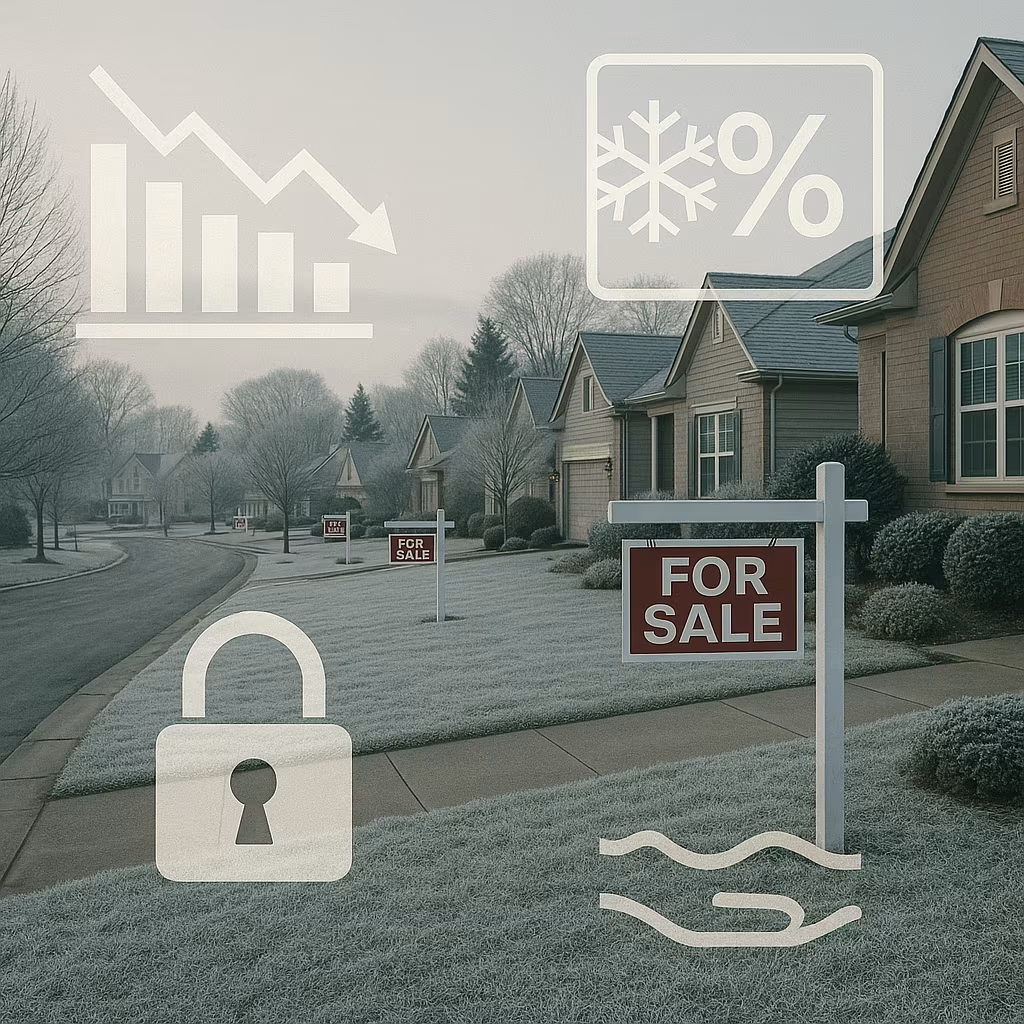For much of the past decade, the U.S. housing market has been defined by fast-rising prices, bidding wars, and record-low mortgage rates. But the narrative has shifted dramatically. What was once a roaring market has slowed to a near standstill, leaving both buyers and sellers locked in place. The latest data, trends, and sentiment all point to the same reality: the U.S. housing market has effectively frozen over.
Mortgage Rates Keep Buyers on the Sidelines
One of the primary culprits behind the market freeze is stubbornly high mortgage rates. After years of ultra-low borrowing costs, the Federal Reserve’s campaign to tame inflation has pushed rates well above 6% and, at times, close to 7%. For many would-be buyers, the jump in monthly payments has made homeownership unaffordable, particularly in already expensive markets like California, New York, and Florida.
This shift in rates has not only cooled demand but also discouraged sellers. Homeowners who locked in mortgages at 2% or 3% during the pandemic have little incentive to trade up or down when moving would double their interest costs. As a result, new listings remain historically low, and the available inventory of homes is stuck at crisis levels.
Sellers Are Staying Put
The so-called “lock-in effect” is one of the clearest indicators of the housing market freeze. Millions of homeowners are effectively trapped in their current properties because selling and buying again would mean paying significantly more for the same or even less space. This phenomenon has created a standstill: fewer homes are hitting the market, and the ones that do often sit longer, even if priced competitively.
In a healthy market, turnover and mobility drive growth. But in today’s frozen market, sellers have become reluctant participants, creating a bottleneck that reverberates throughout the entire economy.
Builders Are Slowing Construction
Homebuilders, who initially tried to fill the gap by increasing construction, are now facing their own slowdown. Rising borrowing costs for development, combined with softer demand, have led many builders to pause projects or scale back future plans. New construction remains below the level needed to meet long-term demand, especially in high-growth regions where population trends point to future shortages.
This slowdown in building compounds the freeze. Without new homes to balance demand, affordability remains strained, and supply remains tight.
Buyers Are Waiting for a Break
On the buyer side, sentiment has dropped to some of the lowest levels in decades. Surveys show that most Americans believe it’s a bad time to buy a home. High mortgage rates, elevated prices, and uncertainty about the economy have created a perfect storm of hesitation. Potential buyers are choosing to rent longer, delay major moves, or simply wait for conditions to improve.
Even in markets where prices have softened slightly, the savings are often canceled out by higher financing costs. For many households, the math simply doesn’t work.
Regional Markets Reflect the Freeze
While national data tells the broad story, local markets bring the freeze into sharp focus. In cities like Austin, Phoenix, and Denver—once red-hot housing markets during the pandemic boom—demand has cooled significantly. Homes that once received dozens of offers now sit on the market for weeks or months.
In traditionally steady markets like the Midwest, activity has also slowed, though prices have remained relatively stable. Coastal markets, where affordability was already stretched, are seeing the most dramatic pullbacks as high prices collide with high borrowing costs.
Rental Market Pressures Are Rising
The freeze in buying has had a spillover effect on rentals. With fewer people able to purchase homes, demand for rentals has surged, keeping rents elevated in many major cities. This dynamic has created challenges for younger Americans and first-time buyers, who are caught in the cycle of paying high rent while being unable to save for a down payment.
The rental market, while strong for landlords, reflects the broader affordability crisis gripping the nation.
The Economic Ripple Effect
The housing freeze is more than a story of buyers and sellers—it has significant implications for the U.S. economy as a whole. Real estate is a major driver of consumer spending, job creation, and local tax revenues. When transactions slow, the ripple effects touch industries from construction and home improvement to furniture sales and real estate services.
A frozen housing market also limits mobility, making it harder for workers to relocate for jobs and for cities to adapt to changing demographics. The economic drag is subtle but powerful, with long-term consequences for growth and stability.
What Could Thaw the Market?
Experts point to several potential developments that could help revive the housing market:
- Falling Mortgage Rates: Even a modest decline in rates could bring buyers and sellers back into the market.
- Policy Support: Government programs aimed at easing affordability, expanding supply, or supporting first-time buyers could provide relief.
- Economic Stability: A more predictable inflation and interest rate environment could restore confidence among both buyers and builders.
- Innovative Housing Solutions: Modular homes, co-living spaces, and other creative models could help ease supply constraints in the long run.
Still, the consensus is that a true thaw will take time. The forces locking the market in place are structural as well as financial, meaning the path forward is likely to be slow and uneven.
The latest signs from across the housing sector are clear: the U.S. market is not simply cooling—it’s frozen. High rates, low inventory, reluctant sellers, and hesitant buyers have created a stalemate unlike anything seen in recent decades.
For homeowners, the freeze means staying put. For buyers, it means waiting and renting longer. For the industry as a whole, it’s a moment of reckoning—one that demands creativity, patience, and perhaps a reimagining of what the future of homeownership in America should look like.





